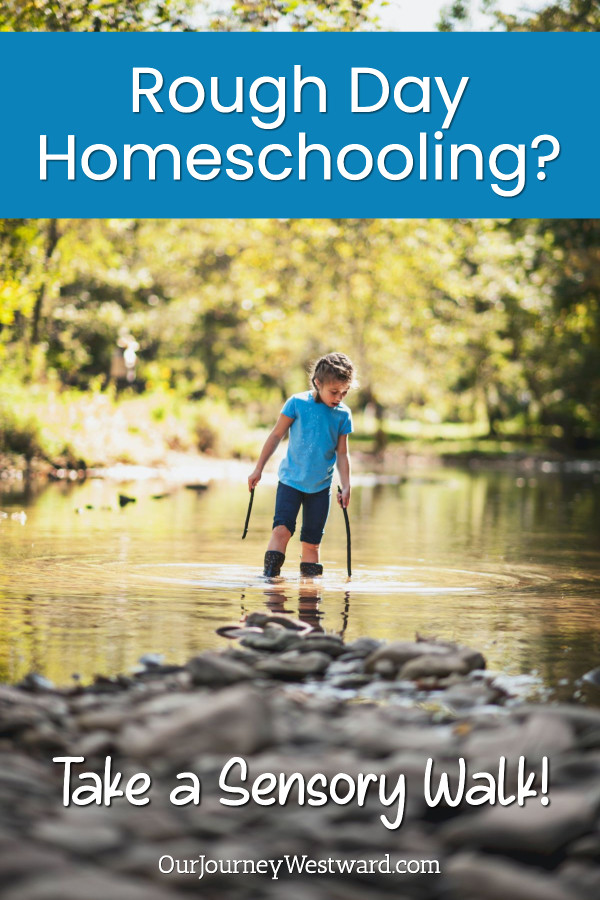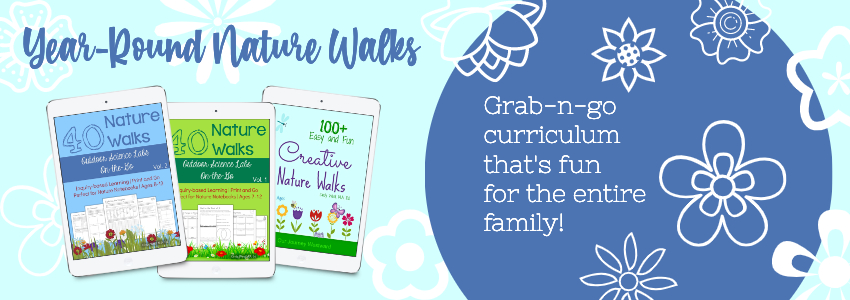Rough Day Homeschooling? Take a Sensory Walk.
No matter how long you’ve been homeschooling or how old your children are, some days just don’t go as planned. A craft doesn’t work out the way you’d hoped, anxiety sneaks in and sets kiddos on edge, siblings bicker, headaches happen, and fatigue creeps up and whispers for a break.
Societal pressure (and our own battles with mom guilt) make us feel like we have to push through. Math manipulatives mock us from the shelf. Maps of the world hang as a reminder of how much more there is outside of our schoolroom. The day is shot, we feel trapped, and we really do need a break. All of us.

Rough days can happen without notice. While no one is immune to them, homeschoolers have the advantage of flexibility. We can adapt, regroup, and turn lemons into lemonade one way or another.
It’s always a good idea to have a few backup plans in place. Documentaries, games, books, or special activities are great to have on standby for times when you might need a sick day or a substitute.
But, on those days when complaints are long and tempers are short, when monotony has snuck in and dulled the senses, or when you just need a quick break or a fun activity to punctuate the day, you might need to simply get out of the house for a reboot.
Take a Sensory Walk
A sensory walk is a mix between a nature walk, a brain break, and a therapy session for those days when homeschooling gets off track. It’s easy to do and can be enjoyed with almost any age group.
With little more than walking shoes required to participate, preschoolers and preteens alike are able to use their senses to appreciate and observe the world around them. All it takes is walking and taking note of what is seen, heard, felt, smelled, and sometimes even tasted. Pretty simple, right?
While sensory walks in nature are my favorite, they’re not limited to the outdoors. A skate park, a museum, an old church, a bus stop, a grocery store, a library, a barn, and other places you can think of are great, too. You can even take a sensory walk inside your own home – and you may be surprised at what you never noticed before!
Not every location will allow for every sense to be explored – after all, there’s not much you’re allowed to touch at an art museum and you wouldn’t want to taste most things you find in a public place. Some sensory walks can focus on simply listening to the activity around you, while others are about taking note of everything that can be seen.
A texture hunt can even be a way to trick your kids into cleaning their rooms or organizing their closets! Throw away every crinkly water bottle, pair all of the fuzzy, ribbed, and smooth socks from the laundry, pick up every smooth, hard Lego, stack the glossy magazines. You’ll be surprised at how many textures can be identified on the floor of a bedroom!
Wherever you end up, begin by letting the kiddos know what the objective is – observing. We have been blessed with five unique senses, and the purpose of the sensory walk is to use those senses to notice, with intention and focus, the sights, smells, sounds, textures, temperatures, and tastes of the world around them.
We live in a fast-paced world with constantly competing stimuli, so pausing to notice a single sense takes practice. Your children may need some guidance as to which senses to hone in on at specific times.
Sensory Walk Examples
Encourage kids to close their eyes when listening so that they aren’t distracted by what they see. Offer sips of water in between nibbles of berries and edible leaves from a garden so that the unique flavors of each treat are able to stand out and be noticed. Take breaths through your mouths to test whether or not you can taste the salt in the air near the ocean or the earthiness of a mossy, muddy forest floor. Compare textures so that the smoothness of the river rocks is more noticeable after running your hands over rough tree bark. Call attention to the difference of temperature in the shade of a tree versus the temperature directly under the sun.
Sensory walks can be as informal or structured as you desire. Some treks may just be for clearing the mind and creating opportunities for conversation, while others can be accompanied by notebooks for jotting down notes, sensations, comparing and contrasting, observing specific species, or drawing from later.
Children can make tallies of the number of red birds they see or how many different types of trees they walk past. Teenagers can strengthen their verbal skills by working to use as many synonyms as possible for the taste of honeysuckle or the smell of a recent campfire.
You may assign a paper or art project that asks your child to summarize their experience, a graph or chart that makes note of the different wildlife, a homemade map, a recipe using found edibles, or any other project that uses experiences and notes gathered from your sensory walk.
Or you can just enjoy yourselves!
A sensory walk is a fantastic opportunity to communicate with your children, as well. Activities that encourage children to share and describe their experiences are practice not only in language but in finding their own unique voice.
Point out how one scent may be appealing to one child and appalling to another as a way to demonstrate differing perspectives. Ask what memories are triggered by the sounds of your walk. Listen to what your children have to say when they describe their surroundings. Ask questions that allow for more than one-word answers. Listen as your kids learn to describe their thoughts and feelings in a format that doesn’t have any wrong answers.
Sensory walks are a perfect way to break up a slow or rough day. Children learn not only to take note of their surroundings, but also how to express themselves, compare and contrast, appreciate differing viewpoints, and look a little deeper than a fleeting glance.
When taught how to use their senses in an active way, children are given an appreciation for what surrounds them. Anxious kids are able to practice focusing on another sense when overwhelmed by their minds. Wiggly kids are able to explore one location in numerous ways. Shy kids are encouraged to share. And parents get front row tickets to their children rediscovering the world over and over.
Other Posts and Resources You Might Like


